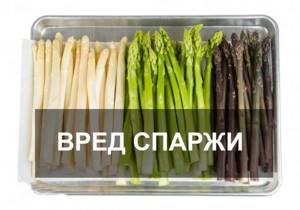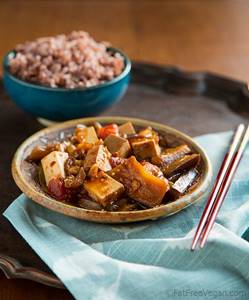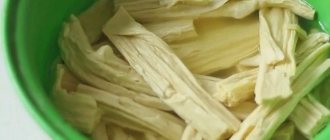Today, adherents of a healthy diet have a varied and wide range of products suitable for cooking. Something has been included in the diet of vegetarians and vegans a long time ago, and a number of products are considered relatively new. For example, someone has already fallen in love with such a food option as soy asparagus. But some people don’t even know him at all. Not everyone is familiar with the origins of this amazing food product. It is interesting to know what benefits and harm soy asparagus brings to the human body. We decided to consider these issues in detail in order to make it easier to understand whether this product is needed in the menu of a healthy lifestyle follower, and if so, then why.
What is this product?
First, we should talk about what Korean asparagus is made from. So, soy asparagus, or fuju, has nothing to do with common asparagus. This product is manufactured as follows:
- soy milk is brought to a boil;
- when a film appears on its surface, it is removed and hung;
- the soy film dries and takes on the elongated shape characteristic of fuju;
- this dried film is soy asparagus.
Fuzhu has an original spicy taste, which makes dishes made from it a real highlight of any holiday table. In addition, nutritionists note its benefits for weight loss, since the calorie content of Korean asparagus per 100 grams is not that much - 105 kcal.
Impact on the body
Korean asparagus has a lot of medicinal properties, but it is recommended to use it carefully.
On a note! Most often, those who practice a vegetarian menu include it in their diet, as it can replace protein foods.
About the benefits
What are the benefits of asparagus in Korean?
- If for some reason you have excluded meat, cottage cheese and eggs from your diet, then this product is fully capable of replenishing the protein deficiency, minimizing the risk of health problems.
- The composition contains essential amino acids, which are the “primary sources of life”, as they take part in all important processes occurring in the human body.
- This product is recommended for use as a prevention of cancer and cardiovascular diseases.
- Isoflavones, which are phytoestrogens, will help normalize hormonal levels in women during menopause, PMS, ovarian failure and underdevelopment of the mammary glands.
- Lecithin prevents the accumulation of fatty tissue, stimulates bile flow and prevents the accumulation of toxins in the liver.
- The low calorie content of Korean asparagus makes it valuable from a dietary point of view; in addition, it helps to normalize metabolic processes, which is especially useful for people suffering from obesity, gastrointestinal dysfunction and diabetes.
- Fiber helps improve intestinal motility, normalizes the digestion process, and removes heavy metal salts, cholesterol and radionuclides from the body.
In addition to its medicinal qualities, this product also has excellent taste, so its use will bring not only good health, but also a huge range of pleasure.
About the harm
However, it is worth remembering that Korean asparagus can only be beneficial if its introduction into the diet is careful, otherwise it will cause harm to health.
- Firstly, too frequent consumption of this dish, as well as other soy products, is fraught with the risk of developing pancreatic diseases.
- Secondly, isoflavones, also known as phytoestrogens, when overdosed, cause thyroid diseases and can cause deviations in sexual development in children.
Therefore, remember that there should be moderation in everything. Korean asparagus, no matter how tasty it is, cannot be consumed daily and in huge portions. Adhere to reasonable restrictions, and this delicacy will definitely bring only benefits to your body.
Soy asparagus: health benefits and harms
Before we talk about how healthy and harmful soy asparagus is, it is worth determining what this product is.
Soybean asparagus is a soybean derivative that is formed during the defibration process of fresh soybeans. The beans are boiled and a thick, oily film is obtained, which is subsequently dried in a special way. It is from this dried soy film that the food element in question is obtained. Essentially, soy asparagus is a protein-rich concentrate of plant origin. It is obtained artificially from a natural healthy base.
Another name for soy asparagus is fuju. This product is very popular in Asian cuisine. Today such a food component is available in our country. Thanks to this, we can cook and eat asparagus.
Soy asparagus: composition and energy value
The chemical composition of this product is curious due to its high content of vitamins and minerals.
The list of included elements includes:
- vitamins of group B (B6, B12, B1, B2, B9, B5), C, E, A, K,
- amino acids,
- calcium,
- potassium,
- magnesium,
- fluorine,
- phosphorus,
- iron,
- magnesium,
- zinc,
- sodium,
- calcium.
Vegetable proteins are of particular value in this product. Soy asparagus is literally full of them.
Energy value per 100 grams of product - 255 Kcal:
- proteins - 42 grams;
- carbohydrates - 24 grams;
- fats - 14 grams.
Soy asparagus: benefits
You can talk about the benefits of this product for hours. And yet, let’s try to sort everything out.
So, soy asparagus has a beneficial effect on different parts of the human body.
For example:
- this product is useful for the prevention of cardiovascular diseases;
- asparagus from soy can be chosen as an additional remedy during the treatment of diseases of the musculoskeletal region;
- This element of food is good for diseases of the gastrointestinal tract;
- the product is allowed on the menu for people suffering from metabolic disorders and diabetes;
- Asparagus is good for weight loss and is acceptable on the menu for obesity;
- this product helps strengthen the immune system;
- with the help of asparagus you can enrich the diet of athletes and people engaged in hard physical labor;
- Asparagus in the diet is good for preserving youth and beauty.
There is a legend that one Chinese emperor of the Qin dynasty chose soy asparagus as the “elixir of youth.”
It is curious that in the modern world it is also recognized that soy asparagus in the diet provides a unique boost of youth and health. It will also be very interesting to learn about the benefits and harms of this product for women. As for the benefits: soy asparagus contains phytoestrogens, which have a beneficial effect on hormonal levels. Plant proteins strengthen and create a healthy background in the female reproductive system. It is useful to eat fuzhu for women during PMS, menopause and in unfavorable conditions of the reproductive system. This product smoothes out the effects of hormonal stress, reduces menstrual pain, and prevents the development of inflammatory processes and bleeding. Fuzhu contains a large amount of antioxidants. The product not only slows down the aging process, but also helps prevent the development of tumor diseases. Soy asparagus removes carcinogens from the body. As for the harm of asparagus to the female body, the possible negative consequences of consuming this product are the same for both sexes. We'll talk about them a little later.
Men will also appreciate the benefits of fuju! After all, this product gives the necessary boost of strength, protects the nervous system from stress, and protects the heart and blood vessels. Eating asparagus from soy also has a beneficial effect on the male reproductive system. When preparing for conception, it is recommended to include this product in your diet 1-2 times a week.
For those who decide to lose weight, this product is simply irreplaceable in the diet. The fact is that the composition of soy asparagus is such that it easily ensures saturation and gives a charge of vigor and strength. At the same time, there were no negative consequences for the figure. On the contrary, the product helps to gently and safely get rid of excess fluid in the body and breaks down fats.
This is an indispensable source of protein for people who have completely excluded meat and other animal products from their diet. By regularly including fuju in your diet, you can practically not worry about such an essential protein component in the menu. This is very useful for both athletes and people accustomed to serious physical activity. However, absolutely all people need protein.
Cooking method
If you don’t know how to cook asparagus in Korean, then we are ready to offer you several recipes. The main ingredient, no matter what dish it is used in, always undergoes the following processing: place the fuchja in a container of cold water and leave until the asparagus is soft.
Advice! If you don’t want to wait a long time, you can pour boiling water over the product! In this case, the waiting time will be reduced from several hours to 30 minutes. But this should be done only as a last resort, since it is recommended to soak soy asparagus in cold water.
Soaked asparagus can be boiled, fried, stewed, added to appetizers, soups or main dishes - all at your discretion.
Famous salad
The most popular dish remains Korean asparagus salad. The recipe for its preparation is as follows.
Prepare ingredients:
- soy asparagus – 100-150 g;
- onion – 1 head;
- vegetable oil – 100 ml;
- garlic – 2-3 cloves;
- sugar - tablespoon;
- salt - teaspoon;
- soy sauce – 2 tablespoons;
- apple cider vinegar - a tablespoon;
- ground coriander, paprika, red pepper - to taste.
Cooking process.
- Soak the dry semi-finished product in water.
- Squeeze out the water from the soaked fuju and cut the product into small pieces 3-5 cm long.
- Heat a frying pan, pour in vegetable oil.
- Cut the onion into rings and fry.
- After the onion gives all its aroma to the oil, it should be removed and garlic should be added to the oil, which is first finely chopped with a knife.
- Place the asparagus on a dish, sprinkle with sugar, salt, add vinegar and soy sauce, mix everything.
On a note! Sometimes I include carrots in the Korean asparagus recipe - they are simply grated on a Korean carrot grater and added raw to the asparagus.
- Remove the pan from the heat, put the spices in the hot oil, stir and pour the resulting marinade over the asparagus.
As you can see, the recipe for making Korean asparagus at home is incredibly simple. Let the finished salad cool and enjoy its incredible taste.
All materials on the website are presented for informational purposes only. Before using any product, consultation with a doctor is MANDATORY!
There are many recipes for cooking asparagus. Chopped pickled vegetables go well with main courses. Thanks to the content of asparagus in the salad, the food acquires a delicate aftertaste. Traditionally, asparagus is prepared as a stand-alone snack from the dried root vegetable. However, butter, carrots, mushrooms, and roasted sesame seeds are often added to the salad. Let's look at popular recipes in order, and provide step-by-step instructions for preparing the Korean snack.
Delicious and healthy dishes made from soy asparagus
It is often called the “product of youth”: fuzhu has a high concentration of essential plant protein, which is absorbed by the body much faster and easier than animal protein. Soy asparagus has many health benefits, but some studies show that it can also be harmful if consumed in excess.
This product contains bioactive substances - phytoestrogens. For women, they are of great benefit: consuming soy asparagus during PMS, menopause, or when the reproductive system is unhealthy will help reduce the risk of developing serious diseases and reduce harm from the influence of unfavorable factors.
Isoflavones, a type of phytoestrogens contained in fuju, which have many beneficial properties, are excellent antioxidants, normalize hormone function, and promote anti-carcinogenic changes. Soy asparagus contains a special substance, lecithin, whose properties improve liver function and prevent the accumulation of fat in the body.
Fuzhu is used not only as an independent dish, but also as an integral element of many other healthy and tasty recipes. Basically, all dishes that include soy asparagus come from the cuisines of East Asian countries - China, Japan, Korea, India:
- With carrots in Korean;
- Korean asparagus with paprika;
- Diet Caesar with soy asparagus;
- Oriental salad with fuju, seaweed and pickles;
- Autumn salad with pumpkin, pear and fuju.
Korean asparagus with carrots is one of the traditional dishes of oriental cuisine, which is prepared there in every home. To prepare this dish you will need the following ingredients:
- dried semi-finished product - 1 package;
- vegetables: onions and green onions, garlic - 3 - 4 cloves, carrots - 1 kg;
- various seasonings to taste. The main ones are black pepper and coriander;
- soy sauce - 1 tbsp. l.;
- vegetable oil (linseed, olive, sunflower, pumpkin or grape seeds);
- vinegar 70% - 1 - 1.5 tbsp.
First you need to soak the fuju.
- Next, start cooking carrots in Korean. To do this, all the carrots must be chopped on a fine or coarse grater (optional), add ground pepper, salt, 1 - 2 tbsp. l. vinegar and leave to infuse for 15 - 20 minutes.
- After this, finely chop the onion and garlic, fry them in vegetable oil in a frying pan along with coriander, add asparagus.
- Pour soy sauce over the entire mixture, stir, and leave to fry for another 5 - 6 minutes. until fully prepared.
- You need to transfer everything from the frying pan to the carrots and put the salad in the refrigerator.
The dish is usually served cold: this is how its taste properties are most noticeable.
This is another popular recipe for making Korean asparagus with your own hands.
First, you also need to soak the dried product in water for several hours.
Meanwhile, you need to prepare the marinade for soy asparagus:
- The base is soy sauce, in which ground black pepper, salt, 1 - 2 tbsp are mixed. l. fragrant paprika, crushed garlic and finely chopped onion.
- The swollen mass is placed in the resulting marinade and left in the refrigerator for 12 hours.
Important! This recipe is complicated because if you overcook the asparagus in soy sauce, its taste will become cloying and sour.
The main benefit of the herb is a large amount of dietary fiber, which contributes to the normal functioning of the intestines and is a preventative against constipation. The saponins contained in the product slightly irritate the mucous membrane of the intestines and stomach, which contributes to the rapid absorption of food.
Asparagus is considered the most effective natural diuretic, allowing you to naturally rid the body of excess fluid. The same property helps to slightly reduce blood pressure. In addition, along with excess fluid, excess salt is removed, which thins the blood and stabilizes the heart rate.
Useful properties of asparagus in Korean
- Asparagus is also called fuchja; the product normalizes the activity of the intestinal tract and eliminates constipation. This feature is due to the large amount of fiber contained in the fruit.
- With regular consumption of snacks, the work of the heart muscle stabilizes, blood flow improves, and brain activity accelerates. Asparagus is extremely beneficial for diabetics as it normalizes glucose levels.
- Beneficial properties include the content of polyunsaturated fatty acids, protein and plant fibers. In combination, these compounds have a positive effect on body weight, reducing cholesterol levels.
- For girls who experience pain during menstruation or endometriosis, asparagus helps relieve discomfort. At the same time, men can avoid cancer of the prostate and intestinal tract.
- Doctors recommend eating asparagus for people suffering from massive hair loss (receding hairline). The vegetable strengthens follicles, accelerates blood circulation to lymph, nourishes the scalp, and promotes accelerated hair growth.
- Soybean semi-finished product is rich in calcium, which improves the structure of bone tissue, nails, hair, and skin. At the same time, the incoming amino acids allow cells to carry out rapid regeneration, normalize the self-cleaning of the epidermis, and “break” sebaceous plugs.
- The soy product smoothes out fine wrinkles, eliminates microcracks, and nourishes the skin with moisture. In most cases, asparagus restores the salt, alkaline, acid and water balance of the body and prevents premature aging of the dermis.
Important!
Despite its undeniable advantages, asparagus can cause individual intolerance. Do not rush to consume the finished product in large portions; first, eat 30-50 grams. and evaluate the body's reaction.
If we talk about shelf life, dry fuju can last a long time, while the finished snack lasts 2 days.
Korean-style soy asparagus: calorie content per 100 grams of product, what it is made from, its benefits and harms
Chinese and Korean cuisine have become very popular in the modern world. Soy asparagus is a dish of national Asian cuisine. She managed to fall in love with many fans of this cuisine. What are the properties of this popular product and its calorie content? What does it bring to the body, benefit or harm?
- Korean soy asparagus
- Calorie content of the product
This product has several names - fuzhu, fupi, douli yuka. Korean soy asparagus is a salad made from dried soy milk foam. This has nothing to do with asparagus. In China and Japan, this dish began to be consumed a very long time ago. The first mentions of it were recorded in the 15th century.
Soy milk foam does not have an exquisite taste, but residents of Asian countries have been able to improve its taste and make it a savory dish.
In Japan, soy milk foam is eaten raw ; in China it is dried. With the right seasonings, soy milk foam can be given a wonderful taste.
This resulted in a delicious and complete Asian dish.
Soy asparagus is made from soybeans. They are crushed and then boiled; at the time of cooking, foam rises above the milk; it is collected and then hung . In this form, it becomes fibrous, after which it is dried and goes on sale.
The product contains a lot of protein, which is why it is used by vegetarians and athletes. The vegetable protein in soy asparagus is completely absorbed by the body. In addition to protein, it also contains a lot of other useful substances:
- minerals;
- vitamins;
- insoluble fibers.
From it they learned to prepare natural soy sauce, milk and cheese for vegetarians. The product contains a large amount of:
- gland;
- magnesium;
- calcium;
- Selena;
- phytoestrogens.
Soy asparagus is rich in fiber, which helps eliminate constipation and improves the functioning of the digestive system.
Soy protein and insoluble plant fiber help lower blood cholesterol levels.
Polyunsaturated fatty acids serve as a prophylactic for the cardiovascular system. Plant estrogens help reduce the risk of breast disease in women.
Due to the selenium content in the product, when consumed regularly, the likelihood of prostate and colon disease in men is reduced.
A high content of amino acids can renew the cells of our body, which improves the condition of the skin and muscles and slows down the aging process of the entire body . If you regularly eat Korean asparagus salad, your hair becomes much better and practically does not fall out. Thanks to phytohormones, soy asparagus is an excellent preventive remedy for osteoporosis.
Calorie content of the product
If we talk about the calorie content of Korean asparagus, this indicator may differ depending on the type of product. It is purchased in two forms - dried or ready-to-eat. The calorie content of the finished dish is 440 kcal per 100 g:
- proteins – 45 g – 180 kcal;
- fats – 20 g – 180 kcal;
- carbohydrates – 20 g – 80 kcal.
The energy value of finished Korean-style asparagus, the BZHU ratio looks like this:
- proteins – 41%;
- fats – 41%%
- carbohydrates – 18%.
This caloric value will allow you to quickly saturate your body and not gain extra pounds. The dish began to be often included in the menu of various diets . If you compare the dish with other protein products, you will immediately notice that it contains more protein and much fewer calories.
Harm or benefit
Research has been carried out repeatedly in the field of soy products. Most scientists believe that excessive amounts of soy foods are harmful to health. Soy can negatively affect the condition of the pancreas . The phytoestrogens contained in soy can cause disorders of sexual development in childhood, and in women lead to disruption of the thyroid gland.
Doctors believe that soy products should be introduced into your diet with caution. No matter how tasty a Korean asparagus dish turns out, you need to eat it little by little and not every day. Only small portions of such a product can benefit the body.
Not long ago it was allowed to use GMOs in the production of soy products , so when buying them you should always pay attention to this indicator. If you constantly consume foods with GMOs, there is a risk of developing cancer.
Korean asparagus is very rich in protein, with a high content of amino acids. Soy asparagus has a pleasant taste. It is used to prepare salads and side dishes, appetizers, and is used as an independent dish. If you prepare a dish correctly, it will reveal all its valuable properties and give you the opportunity to enjoy a pleasant taste.
Source: https://dietolog.guru/produkty-i-pohudenie/dieticheskie-blyuda/iz-chego-delaetsya-sparzha-po-koreyski-i-ee-kaloriynost.html
Korean asparagus: a classic of the genre
- garlic - 4 pcs.
- soy sauce - 85 ml.
- dried asparagus - 180-190 gr.
- granulated sugar - 15 gr.
- fine salt - 12-15 gr.
- table vinegar 6% (optional) - amount at your discretion
- onion - 1 pc.
- spices for carrots in Korean - to taste
- vegetable oil (for frying) - in fact
- Soak the asparagus in cold filtered water and leave for 7 hours. After the allotted time has passed, squeeze out the slices and chop the vegetable into strips (4-6 cm long). To make the appetizer look beautiful when serving, cut the asparagus diagonally (the cut will be visible).
- Next, peel the onion, chop it, and begin heat treatment. Pour oil into the frying pan and heat at maximum power. Reduce the heat on the burner and fry the onions. When the vegetable turns golden brown, turn off the stove.
- Combine soy sauce and vinegar. Pass the garlic through a press. Pour the oil from the frying pan into a separate bowl, add the garlic, and season the chopped asparagus with the sauce.
- Add fried onions, granulated sugar and salt, a mixture of table vinegar and soy sauce, and Korean carrot spices. Stir the mixture until smooth.
- Place the snack in an airtight container and refrigerate for 4 hours. The duration of exposure directly affects the final result. The salad will turn out tastier if you leave it for about 6-10 hours.
How to cook soy asparagus at home
It's very easy to prepare: it won't take more than 30 minutes, but some preparation is required.
- The dried product must be soaked in cool water for at least 4 hours. If it is not possible to leave it for such a long time, then you can simply pour boiling water over the fuju and leave it for a couple of minutes to swell. But with this method of cooking, the taste will be much less pleasant, and many of the aromas and beneficial properties of soy asparagus will not be fully revealed.
- After soaking in water, it needs to be washed and cut into pieces.
- As a supplement, you can choose any healthy vegetables: most often, these are onions, carrots, as well as legumes - beans, chickpeas.
- First, the vegetables are fried in vegetable oil in a deep frying pan until medium cooked and only then soy asparagus is added.
- Next, you need to thoroughly mix all the ingredients and leave to simmer under the lid for 7 - 10 minutes.
- For decoration and the final touch, you can sprinkle the dish with herbs - green onions, dill, then crush the garlic and sprinkle with pepper.
Korean asparagus: a quick way
- table vinegar (6-9%) - 55 ml.
- dried asparagus - 225 gr.
- drinking water - 110 ml.
- carrots (large) - 1 pc.
- garlic - 3 cloves
- sunflower oil - 110 ml.
- salt - to taste
- sugar - 15 gr.
- crushed red pepper - 1-2 pinches
- Boil drinking water, pour it over dried asparagus, leave for 1 hour. Rinse and chop the carrots; if possible, use a grater to prepare the Korean carrot salad (diamond-shaped).
- Add the chopped vegetable to the soaked and squeezed asparagus, and squeeze the garlic in there. Stir, cover the container with a lid and let sit for half an hour.
- Start preparing the marinating mixture. Combine seasonings with granulated sugar and salt. Pour in the vinegar solution, transfer the mixture to a saucepan, and place on the stove.
- When the mixture begins to bubble (the first bubbles appear), turn off the burner. Pour the prepared mixture over the asparagus, garlic and carrots. Place the snack under pressure, keep it for 1 hour at a temperature of 25 degrees, then move it to the cold.
Creamy asparagus
- granulated sugar - 20 gr.
- asparagus - 475 gr.
- lemon juice - 55 ml.
- butter - 60 gr.
- salt - 30 gr.
- Wash the asparagus, remove rough areas (bottom area). Boil the fruit for 10 minutes, then turn off the stove. Drain the solution in which the heat treatment was carried out (it will be useful for preparing the sauce).
- Divide the boiled asparagus into fibers or chop into slices diagonally (cut obliquely). Pour filtered water into the pan, add salt, sweeten (optional), add lemon juice. Cook the vegetable for another half hour.
- Melt the butter in a convenient way and pour into a saucepan. Remove the boiled asparagus and pat dry with paper towels. Transfer the appetizer to flat plates and pour over the creamy sauce. Serve asparagus with sliced ham, cheese, and walnuts.
- garlic - 2 cloves
- sugar - 5 gr.
- salt - 5-10 gr.
- black sesame - 10 gr.
- white sesame - 5 gr.
- dried asparagus - 230-250 gr.
- oil (vegetable or olive) - in fact
- carrots - 1 pc.
- crushed paprika - to taste
- spices for carrots in Korean - 10 gr.
- apple cider vinegar - 55-60 ml.
- Pour cold drinking water over the asparagus and leave to soak for 5 hours. If possible, soak the vegetable overnight. After the allotted time has passed, squeeze out the mixture and chop it into pieces diagonally.
- Take a grater for preparing carrots in Korean, pass the washed vegetable through it. If you don’t have a special device, use a regular grater.
- Combine chopped carrots with chopped asparagus, salt, sweeten (optional), add seasonings. Fry the sesame seeds in a hot dry frying pan and add to the main mixture.
- Pour in the vinegar solution and heat the vegetable or olive oil to maximum. When the mixture begins to bubble, pour it over the asparagus, carrots and seasonings.
- Shake the container several times to avoid damaging the contents. Leave the appetizer in the cold for 3-5 hours, during which time the Korean asparagus will infuse and become especially tasty.
Asparagus with champignons
- vegetable oil - in fact
- champignons - 280 gr.
- dried asparagus - 200 gr.
- onions - 1 pc.
- seasonings for Korean carrots - to taste
- salt - 10 gr.
- Cover the asparagus with drinking water and let stand for 3-5 hours. After the specified time has elapsed, remove the vegetable and squeeze it. Chop into slices diagonally.
- Rinse and clean the champignons, cut them into slices along the stem. Heat vegetable oil in a frying pan and fry the mushrooms for a quarter of an hour.
- After this, sauté the onions, first chopping them into half rings. Drain the oil remaining after frying the mushrooms and onions into a separate container and add the asparagus to it.
- Place the dish under a press for 1 hour, then mix with mushrooms, onions, and salt. Transfer to an airtight container and refrigerate for 4 hours.
Korean asparagus has a lot of beneficial properties, so it is important to learn how to cook it correctly. Consider recipes for snacks with cream sauce, add lemon juice, mushrooms, carrots, onions, favorite seasonings and apple cider vinegar. Vary the proportions based on personal preference.
Video: Korean asparagus recipe
Recently, a salad called “Korean-style asparagus” has become quite popular in our country. Interestingly, they have never heard of such a dish in Korea. And all because, paradoxically, the residents of that region do not know the recipes for preparing this product.
What kind of salad is this? What beneficial properties of this dish are known to nutritionists? Is the product high in calories? How to make a marinade so that Korean asparagus is as healthy as possible? Let's try to understand these and other issues.
Korean soy asparagus for weight loss
Due to the low calorie content of Korean asparagus, it is often used in various weight loss programs and diet courses. Korean asparagus has a pleasant taste, so it should be included in the daily diet not only for those who want to lose weight and follow a strict diet, but also for those who want to diversify their diet.
Important! Nutritionists advise eating this semi-finished product in the afternoon - for lunch or dinner. Thus, healthy vegetable protein will be absorbed in the best possible way and will bring more benefits to the body, and carbohydrates and fats will not be deposited in the body as excess weight and will not cause any harm.
Unique product
Soy asparagus, also known as fuju or yuca, is a semi-finished soybean product that the Chinese prepare as a national dish.
The main ingredient used in Korean asparagus recipes is not directly related to the plant of the same name. It is correct to call it yuca in Japanese, fuzhu in Chinese, or at least Chinese fern.
How to make asparagus in Korean if this plant is not its basis? The product is prepared from soy milk, which is boiled until a film appears on its surface - fupi. If you hang this film, it takes on an interesting elongated shape. When it dries, it becomes fuzhu.
You may be wondering what exactly is soy milk? In fact, it is ordinary soybean, crushed until smooth and then boiled.
Milk is prepared very simply:
- First, soybeans are soaked and infused in water;
- then cook over low heat, strictly observing the required proportions of soy and water;
- and at the very end they grind and decant.
The smell of such milk is quite pleasant, the color is natural, but it has no taste as such.
Another thing is the Chinese fern. Its taste is original and piquant, so having Korean asparagus salad on the table will be the highlight of your dinner party. In addition, as nutritionists note, thanks to fuzhu you can improve your health and lose excess weight.
Incredible Health Benefits
What else is useful for Korean asparagus? It contains isoflavones - these are substances that are part of the group of phytoestrogens.
They will help improve your health if a woman has an excess or deficiency of her own hormones:
- during the period of PMS;
- during menopause;
- with underdevelopment of the mammary glands;
- with ovarian dysfunction.
Isoflavones exhibit a remarkable estrogen-like effect, normalize hormonal patterns, have an anticarcinogenic effect and are antioxidants.
Have you been prescribed a therapeutic diet for a peptic ulcer? Then Japanese yuca will fit perfectly into your adjusted diet.
It contains lecithin, which prevents the accumulation of fats and toxins in the liver, while increasing the flow of bile, and soy fats do not contain cholesterol that is undesirable for the body.
Due to the high dietary value of Chinese fern, its low calorie content and remarkable effect on metabolic processes, Korean asparagus becomes an indispensable product for people with problems such as obesity, diabetes, and gastrointestinal disorders.
Like many other products of plant origin, fuju contains a large amount of fiber, which can improve intestinal motility, normalize digestion, remove toxins, heavy metal salts, radionuclides and cholesterol from the body.
With all these wonderful properties, Japanese-style pickled yuca also has an incomparable taste. By regularly eating it, you will improve your health and be able to lose weight by replacing higher-calorie foods with salad, and you will get a whole range of taste pleasures by preparing the delicacy.
Harm of asparagus

Despite all the positive qualities of this product, asparagus also has negative qualities, like any product. As they say, everything should be in moderation without going overboard.
Asparagus can in rare cases cause allergies. It is also not recommended to use this product if you have a stomach ulcer. Men and women are not recommended to eat asparagus if they have prostatitis and cystitis, respectively.
There should be good in moderation
Like any other remedy that has medicinal properties, fuju should be added to the diet with caution so as not to have the opposite effect on health.
A number of studies indicate a connection between consumption of soy foods in inappropriately large quantities and the risk of pancreatic diseases. There is also evidence that phytoestrogens, the beneficial properties of which were discussed above, with frequent use can cause thyroid diseases in women, and deviations in sexual development in children.
Japanese Yuka should not be eaten every day and in moderation. If you adhere to reasonable restrictions, the delicacy will only bring benefits and delight you with its excellent taste.
Cooking methods
Do you want to diversify your menu with a fuju dish, but don’t know where to start? First of all, soak it until soft in cold water or pour boiling water if you don’t want to wait long. Then it can be boiled, fried, or used to prepare appetizers, soups or main courses.
But perhaps the most popular dish is still salad. After soaking, Korean pickled asparagus is made by adding carrots, peppers, garlic and a little hot oil to the Chinese fern.
There is no need to restrain your imagination. Try playing with the ingredients and proportions until you achieve the most piquant taste.
Here are a few recipes that you can easily use when preparing fuju at home.
"Dry asparagus"
Ingredients:
Cooking method:
- Pour boiling water over the main product and let it brew for an hour. During this time, you will have time to heat the frying pan and fry the onions, previously cut into half rings, in it.
- Vegetable oil will become a dressing for your dish, but the onion itself can be thrown out or left if desired.
- Add crushed garlic, a little pepper and then soy sauce to the marinade, fry well in a frying pan. After this, pour the mixture over the strained and water-dried soybean asparagus, stir and let cool. Taste the dish and add oriental spices and salt if necessary.
Soy soup
Ingredients:
- Soy asparagus;
- Sweet carrots;
- Coriander;
- Garlic.
The combination of seasonings gives the dish the flavor of many people’s favorite Korean carrots.
Moreover, the first one is somewhat reminiscent in taste of traditional winter soup, which is boiled in broth with pasta and carrots.
Cooking method:
- Soak 60 g of dry product in water, do not throw it away. It can be used to make soup. An alternative to fuju is firm tofu.
- Cut the soaked main ingredient into pieces, grate the carrots on a fine grater or chop them with a knife. We do the same with peeled garlic. To prepare the dish you will need 4-5 cloves.
- Then simmer the garlic, carrots, and ground cilantro seeds in a tablespoon of vegetable oil, stirring constantly. Add water, chopped soy cubes and stewed dressing to the soup pot.
- Bring the dish to a boil. Cook the soup over medium heat, adding a little salt to the water. It is served hot.
Try adding fuju salads and soups to your diet - you won’t regret it. Thanks to this unique herbal product, you will become healthier, lose weight and experience new taste sensations!
One of the popular dishes of Asian cuisine is soybean semi-finished product.
It has a dough-like consistency. It is obtained from soy milk - more precisely, from milk foam obtained by boiling. She even has her own name: fupi. Then it is pulled out and dried. In China this dish is called fuju, in Japan - yuca, and in the CIS - asparagus in Korean.
Attention!
Buy soy products exclusively from stores and supermarkets that are famous for the quality of their products. Study the packaging carefully. If something in the composition seems suspicious, it is better to refuse the purchase.
Fuzhu or soy asparagus
Hello! If you are a vegetarian athlete, fasting, a lover of Chinese cuisine, or are looking for culinary adventures on your plate, then I advise you not to ignore such an interesting product, which in Russia is known under the name “Soy asparagus” .
Since our readers are international, in your region it may be known by code names: soy foam, fuju, fupi, yuba, soy sticks or tofu skin, which is what it essentially is. This is a very fatty, hard skin skimmed from soy milk during the preparation of tofu. Like all soy products, it is rich in vegetable protein (45 grams per 100 grams of dry product), is very nutritious (440 kcal per 100 grams of dry product), and, having a neutral taste, can be included in a wide variety of dishes.
Therefore, today we will look at two options for using it - on its own and with stewed eggplants.
First, we will prepare it. It is usually sold dry. We count out the amount of dry product we need, break the long sticks into smaller pieces, fill them with warm (not hot) salted water in a ratio of 1:4 and leave for 8-10 hours. (I tried leaving it for 3-4 hours - it didn’t have time to soften enough, but you can eat it).
Then drain the water, sprinkle with soy sauce, wine vinegar, add a clove of crushed garlic, a little salt and pepper, and chili pepper. You can add oil, but in general, asparagus is very fatty (20 grams per 100 grams of dry product), so I don’t add oil.
The simplest thing is to make it in hot chili sauce and serve with green onions.
Soy asparagus (fuju) with chili paste
For 2 servings:
- Soy asparagus – 120 gr. (soak in advance)
- Vegetable oil – 3 gr.
- Chili paste – 40 gr. (or tomato paste, but then you need even more chili).
- Rice vinegar – 2 tbsp.
- Soy sauce – 1 tbsp.
- Spices and herbs - salt, pepper, star anise, a pinch of dried chili, green onions, fresh chili, sesame seeds.
Grind the soaked asparagus into segments 2-3 cm in size. Heat a drop of our oil in a frying pan (wok), add chili paste, wait 20-30 seconds, add soy sauce, vinegar, chopped and dried chili peppers, and pieces of asparagus. Mix everything quickly, reduce the heat, and leave to simmer for 10-15 minutes until the asparagus absorbs the aromas of the sauce and spices. Then sprinkle with onions and sesame seeds, and serve with brown rice, or noodles, or any of your favorite side dishes.
Serving yield from the specified amount (about 150-170 grams): 330 kcal, protein (B) - 28 g, fat (F) - 14 g, carbohydrates (C) - 25 g.
If you want to somehow add some “zest” to asparagus, then you can prepare a completely win-win option -
Eggplant with soy asparagus in spicy sauce

For 2 servings we will need:
- Soy asparagus – 120 gr. (soak in advance)
- Eggplants – 400 gr.
- Tomatoes – 200 gr.
- Garlic – 6 cloves.
- Fresh ginger – 30 gr. (peel and grate)
- Soy sauce – 2 tbsp.
- Oyster sauce – 1 tbsp.
- Rice vinegar – 1-2 tbsp.
- Tomato paste – 30 gr.
- Oil (sesame oil is ideal, but you can replace it with olive oil) – 5 g.
- Spices – salt and pepper, dried chili, sesame.
It looks complicated, but in fact, everything is simple. Soak the asparagus in advance, drain the water, cut into cubes of the desired size.
Cut the eggplants into small cubes. Simmer them in a saucepan with a drop of oil and water! Yes! Eggplants cook well and don’t require the amount of oil in which they are usually “bathed” in restaurants. I sometimes do another “cheat”: I cut them into 3*3 cm pieces, salt and pepper, and put them in the oven for about 15 minutes. While I peel and cut the garlic and prepare the spices, they bake, but retain their shape, and then you don’t even have to spend time stewing.
So here it is. Somehow you got the eggplants done. Add to them all the above ingredients - grated ginger, crushed garlic, soy sauce, oyster sauce, vinegar, tomato paste, salt and pepper, chili. Mix, add pieces of asparagus and diced tomatoes. Leave to simmer for 15 minutes. If it gets a little dry, you can add 100-150 grams of water.
When ready, serve with rice, buckwheat, bulgur or on its own, sprinkle with sesame seeds and enjoy.
Serving yield from the specified amount (about 150-170 grams): 454 kcal, protein (B) - 33 g, fat (F) - 15 g, carbohydrates (U) - 46 g.
As you can see, the calorie content is still 440 kcal per 100 grams. makes all asparagus dishes, well, very nutritious and very fatty.
60 grams of dry product per serving used in the recipe is a protein replacement for 100 grams of chicken breast. Alas, the calories are 60 grams. asparagus is twice as much as 100 grams of chicken. But to preserve our muscles, we will sigh, but save in other places - replacing side dishes with vegetables, or simply increasing the calorie content of the diet.
In any case, with a lean and vegetarian diet we have no other sources of protein, so we turn around










